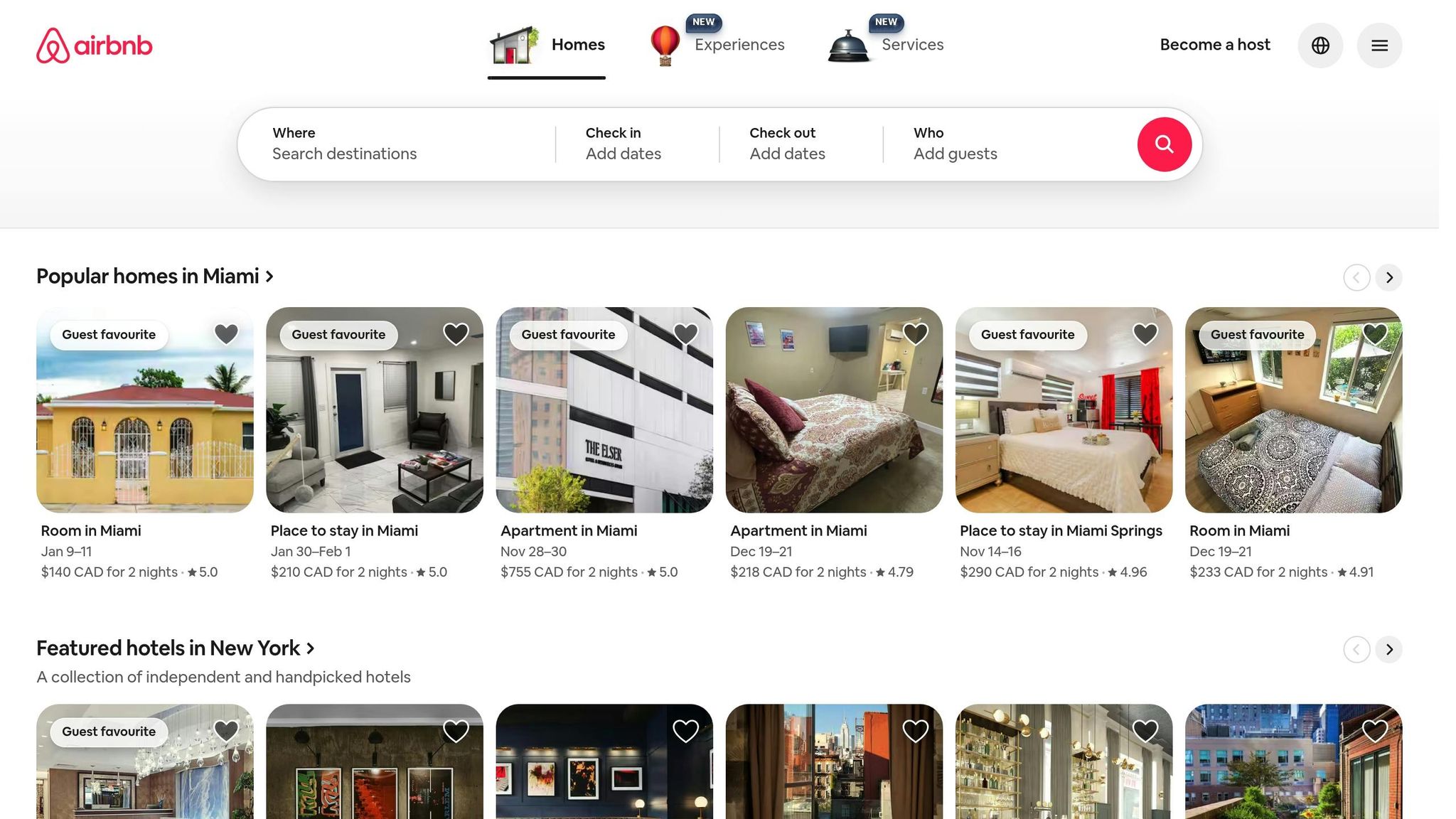Maximizing revenue for short-term rentals on Nova Scotia’s South Shore comes down to balancing two key metrics: occupancy rate and average daily rate (ADR). Higher occupancy means more bookings but often at lower rates, while a higher ADR can boost income per night but may lead to fewer reservations. The goal? Find the balance that generates the most revenue overall.
Here’s what you need to know:
- Seasonal Trends: Peak months like July and August allow for higher rates due to increased demand, while quieter months like November require competitive pricing to maintain bookings.
- Occupancy Rate: Measures how often your property is booked. South Shore averages vary significantly by season, with summer months seeing the highest rates (e.g., July occupancy can reach 86.8% in First South).
- ADR: Reflects revenue per booked night. Higher ADRs are achievable during peak seasons but require standout features or premium locations to sustain in off-peak periods.
- Balancing Strategies: Use dynamic pricing tools, monitor local trends, and adjust rates based on demand, events, and competitor performance. Consider offering discounts for extended stays or early bookings during slower months.
The right approach depends on your property’s location, market demand, and financial goals. Flexible pricing and regular performance tracking are key to optimizing both occupancy and ADR for year-round profitability.
It took me 10 years to create this Airbnb Pricing Strategy

1. Occupancy Rate
The occupancy rate reflects how often a property is booked. It's calculated by dividing the number of nights booked by the total available nights, then multiplying the result by 100. For hosts in South Shore, understanding these patterns is essential, as seasonal shifts can greatly influence yearly income.
Seasonal Performance
Occupancy rates in the South Shore region clearly mirror its seasonal tourism trends. First South, one of the stronger-performing areas, has an annual average occupancy rate of 58.5% [1]. However, this average conceals significant seasonal swings that hosts need to account for.
During the peak months of July, August, and September, First South properties see occupancy rates climb to an average of 72.9%, with July standing out at an impressive 86.8% [1]. On the flip side, the low season months - February, April, and November - bring rates down to an average of 50.5%, with November dipping as low as 33.7% [1].
Other South Shore communities face even steeper challenges. For example, Hubbards has a yearly average occupancy of 32.8%, peaking at 59.1% in August but dropping to 24.4% in February [2]. Similarly, Shelburne averages 36.3% annually, with August reaching 49.1%, but April sees a sharp decline to 21.1% [3].
Revenue Impact
While higher occupancy rates don’t always translate to higher revenue, they do create a steady income flow. Properties with consistent bookings benefit from reduced marketing costs per reservation and spread fixed expenses like insurance, utilities, and maintenance over more nights.
This steady income becomes especially important during the shoulder seasons. For instance, a property maintaining 45% occupancy in October could bring in more revenue than one with 25% occupancy, even if the latter charges slightly higher nightly rates. The key is knowing your break-even occupancy rate - the minimum percentage of bookings needed to cover operating costs.
Pricing Strategies
To maximize occupancy, flexible pricing strategies are crucial. Many successful South Shore hosts use tiered pricing, charging premium rates during the busy summer months of July and August, then gradually lowering prices during the shoulder seasons to keep bookings steady. Offering discounts for reservations made 60–90 days in advance can also help fill slower months, easing the pressure to slash prices last minute.
Market Competitiveness
Occupancy rates also act as a yardstick for gauging a property's performance in the local market. If your occupancy is significantly below the regional average, it could point to issues with pricing or the property itself. On the flip side, rates well above the average might indicate room to raise prices strategically.
Given the tourism-driven economy of the South Shore, local attractions and events play a big role in shaping occupancy patterns. Properties near popular destinations - like Lunenburg’s UNESCO World Heritage site or Mahone Bay’s festivals - tend to achieve higher occupancy than those in more remote areas. Recognizing these local factors helps hosts set realistic goals and adjust strategies based on their property’s location and features.
Keeping an eye on competitors’ occupancy rates, when possible, can also provide valuable insights into your market position. This information can help fine-tune pricing and marketing efforts. Understanding these occupancy trends sets the stage for evaluating ADR, which will be covered next.
2. Average Daily Rate (ADR)
While occupancy rates measure how often a property is booked, the Average Daily Rate (ADR) focuses on how much revenue is generated per booking. Both metrics are essential for optimizing revenue. ADR is calculated by dividing total revenue by the number of nights sold. For South Shore hosts, this metric is particularly valuable in understanding pricing potential, especially in a market with significant seasonal fluctuations.
ADR plays a distinct role in revenue generation. For instance, a property charging $200 per night with a 40% occupancy rate earns more than one charging $120 per night with a 60% occupancy rate over the same period. This is especially relevant for South Shore hosts managing shorter peak seasons, where maximizing revenue per night becomes critical.
A higher ADR offers several financial benefits. It reduces the need to rely on full occupancy to hit revenue goals and helps cover fixed costs like property taxes, insurance, and maintenance - expenses that persist even during off-peak months. Even a small increase in ADR can have a noticeable impact. For example, raising rates by $25 over 100 nights results in an additional $2,500 in revenue. During peak seasons, when guests are less sensitive to price, this pricing power becomes even more valuable.
Seasonal Performance
Seasonal demand heavily influences ADR for premium properties in the South Shore. Winter months often pose challenges for maintaining ADR, which differ from the hurdles of occupancy. Some hosts find that keeping rates higher during low seasons protects profit margins, while others prefer moderate rate reductions paired with added perks. This approach avoids steep price cuts that could harm the property’s perceived value.
Properties near year-round attractions or business hubs often enjoy more consistent ADR throughout the year. For example, accommodations close to Halifax or featuring winter-friendly amenities like fireplaces and heated areas tend to maintain stronger rates during the shoulder months. In contrast, summer-only cottages often see more pronounced seasonal fluctuations.
Pricing Strategies
Dynamic pricing is a powerful tool for maximizing ADR. Many South Shore hosts rely on data-driven systems that adjust rates based on factors like local events, weather conditions, and booking lead times. Tools like Casa Scotia’s dynamic pricing system automatically adapt rates to reflect market trends.
Weekend pricing is another effective strategy in this market. Friday and Saturday nights, particularly in the summer, can command 20-30% higher rates than weekdays, as Halifax residents often seek weekend escapes. Holiday weekends, such as Victoria Day, Canada Day, and Labour Day, also present opportunities for premium pricing.
Offering lower discounts for longer stays is another tactic that works well. While the ADR may be slightly lower, the reduced turnover and cleaning costs can lead to higher overall revenue. This approach is especially effective for properties aiming to balance profitability with operational efficiency.
Market Competitiveness
Striking the right balance between ADR and occupancy is key to staying competitive while maximizing earnings. In the South Shore market, properties achieving higher-than-average ADR often boast standout features such as waterfront access, high-end finishes, or unique architectural designs, which justify premium pricing.
Location is another critical factor in ADR potential. Properties within walking distance of Lunenburg’s historic district or Mahone Bay’s shops tend to command higher rates than those requiring a drive to attractions. Similarly, waterfront properties with private beach access or docks can maintain strong ADR even during slower seasons.
Understanding your property’s ADR ceiling - the highest rate the market will support - requires continuous market analysis. This ceiling shifts with seasonal demand, local competition, and broader economic trends that affect travel spending. If your property consistently reaches its ADR ceiling, it might be time to consider upgrades or added services to push rates higher.
Conducting competitive ADR analysis can also uncover opportunities. If similar properties in your area are achieving significantly higher rates, it may indicate room for strategic rate increases or highlight areas where your property could improve to justify higher pricing. By staying informed, South Shore hosts can refine their strategies and maintain a competitive edge.
sbb-itb-b5e1074
Benefits and Drawbacks of Each Approach
When it comes to managing vacation rentals on the South Shore, every strategy has its upsides and downsides. Choosing between prioritizing occupancy or Average Daily Rate (ADR) depends on your unique situation, financial goals, and the dynamics of the local market. Let’s break down the pros and cons of each approach to help hosts make informed decisions.
High occupancy strategies offer a steady and reliable cash flow. With consistent bookings, hosts can reduce guest acquisition costs since repeat guests and positive reviews naturally lower marketing expenses. This strategy is ideal for those who value predictable income and prefer a constant stream of bookings over chasing peak-season earnings. Additionally, properties with high occupancy often build a loyal customer base, which can result in long-term stability.
That said, focusing on occupancy comes with its challenges. Lower rates mean hosts need significantly more bookings to achieve the same revenue as properties with premium pricing. This can lead to higher operational workloads, including frequent turnovers and increased wear and tear on the property. Hosts may also miss out on higher earnings during peak summer months in Nova Scotia when guests are willing to pay premium prices.
High ADR strategies, on the other hand, focus on maximizing revenue per booking. This approach allows hosts to generate substantial income with fewer bookings, which reduces the time and effort spent on property management. It’s particularly effective during the South Shore's shorter peak seasons, where every booking counts. Premium pricing often attracts guests who are willing to pay more for quality, leading to better profit margins and potentially less wear and tear.
However, this approach isn’t without risks. High ADR properties are more vulnerable to market fluctuations and unexpected events, which can result in higher vacancy rates. Marketing demands are also greater, as attracting guests willing to pay premium prices often requires targeted efforts. Additionally, bookings may require longer lead times, making it harder to fill gaps in the calendar.
| Approach | Benefits | Drawbacks |
|---|---|---|
| High Occupancy | Steady cash flow; Lower marketing costs; Repeat guests; Consistent usage | Limited revenue potential; Higher operational workload; Missed peak earnings; More wear and tear |
| High ADR | Higher revenue per booking; Less guest management; Attracts premium guests | Higher vacancy rates; Greater marketing needs; Sensitive to market changes; Longer booking lead times |
Seasonal factors also play a significant role in determining which strategy works best. During the peak summer months of July and August, when Halifax residents flock to the South Shore for vacations, high ADR strategies often thrive regardless of occupancy rates. However, in shoulder seasons like April or October, premium properties may struggle to maintain occupancy, while budget-friendly options tend to attract cost-conscious travellers.
The type of property you own also matters. Waterfront cottages with standout features can often sustain high ADR pricing throughout the year, while more standard accommodations may perform better with occupancy-focused pricing during off-peak periods. Using dynamic pricing tools can help hosts adapt to seasonal trends, ensuring they maximize revenue during peak periods while staying competitive during slower months.
Ultimately, flexibility is key. Successful South Shore hosts often switch between occupancy and ADR strategies depending on market conditions, seasonal demand, and their financial objectives. Balancing these approaches ensures long-term profitability while adapting to the ever-changing rental landscape.
How to Balance Occupancy and ADR
Striking the right balance between occupancy and average daily rate (ADR) takes a thoughtful, strategic approach. It’s all about adapting to market trends, seasonal shifts, and the unique aspects of your property. Many successful South Shore hosts rely on data-driven tools and flexible pricing strategies to make the most of their revenue opportunities year-round.
At the core of this approach is dynamic pricing. Adjusting rates in real time allows you to capitalize on high-demand periods while staying competitive during slower times. Start by calculating your fixed costs - like mortgage payments, insurance, utilities, and maintenance. This gives you a clear idea of the minimum nightly rate needed to cover expenses. With this baseline in mind, you can ensure that even low-demand bookings contribute positively to your bottom line. From there, you can refine your strategy with tools like seasonal analysis and market comparisons.
Seasonal demand analysis helps you understand local booking trends. For example, summer often brings higher demand, making it easier to charge premium rates. In contrast, shoulder seasons might require a more balanced approach, including incentives like mid-week discounts or extended-stay promotions to maintain occupancy without drastically lowering your ADR.
Another key tactic is market benchmarking. Research similar properties in your area to see how they’re pricing their listings, what amenities they offer, and how they perform during different times of the year. Properties with standout features - like ocean views or unique designs - can often command higher rates than more standard accommodations.
To measure how your pricing and occupancy strategies are working, track your revenue per available night (RevPAN). This metric shows how shifts in ADR and occupancy affect your overall revenue, helping you decide whether to focus on raising rates or filling more nights.
Casa Scotia’s dynamic pricing tools can simplify this process. Their system analyses local market trends, seasonal patterns, and booking behaviours to automatically adjust your rates for optimal revenue. Detailed monthly reports also break down your property’s performance, giving you the insights you need to refine your pricing strategies. With their expertise in South Shore tourism, Casa Scotia helps hosts tailor their approach to Nova Scotia’s coastal market.
Flexible booking policies also play a big role in balancing occupancy and ADR. For instance, offering discounts for extended stays during slower periods or setting minimum stay requirements during peak times can attract a wider range of guests while maintaining profitability. For last-minute bookings, a small discount might help fill otherwise empty nights, ensuring you’re maximising revenue.
It’s essential to regularly review your performance data and compare it to historical trends and market benchmarks. This ongoing analysis can help you fine-tune strategies like mid-week pricing adjustments or promotional offers.
For hosts who split their property between personal use and rentals, it’s important to account for personal stays in your revenue planning. Casa Scotia’s management solutions are designed to accommodate personal use while still maximising rental income during available periods.
Finally, keep an eye on local weather and community events. These factors often create pricing opportunities. For instance, unpredictable spring weather might call for flexible packages, while special events can justify premium rates. By staying responsive to these variables, you can keep your pricing competitive and your bookings strong.
Conclusion
Maximizing revenue for your South Shore rental hinges on striking the right balance between occupancy and average daily rate (ADR). High occupancy ensures a steady stream of bookings, even at slightly lower rates, while a premium ADR allows you to earn more per booking with fewer reservations.
The key to success lies in blending these approaches based on seasonal demand, local events, and market trends. For example, during the busy summer months, it's often possible to enjoy both high occupancy and elevated rates. In contrast, during quieter shoulder seasons, offering competitive pricing or extended-stay discounts can help maintain steady bookings.
One of the most powerful tools at your disposal is dynamic pricing. This approach lets you adjust rates in real time, capitalizing on peak demand while staying competitive during slower periods. It’s a strategy that ensures you’re always aligned with market conditions.
Understanding your property’s unique position in the market is equally important. If your rental offers standard amenities, focusing on consistent occupancy through attractive pricing might be the best route. On the other hand, more distinctive properties can often command higher rates, even with fewer bookings.
Casa Scotia’s management solutions and dynamic pricing tools are designed to help hosts navigate these challenges. Whether you’re looking for year-round management to secure steady income or peak-season strategies to maximize summer profits while keeping the flexibility for personal use, their services offer tailored solutions to meet your goals.
FAQs
How can hosts in Nova Scotia's South Shore use dynamic pricing tools to optimize occupancy and revenue?
Hosts in Nova Scotia's South Shore have a valuable resource at their fingertips: dynamic pricing tools. These tools use real-time data to fine-tune nightly rates based on factors like market demand, local events, and seasonal patterns. The result? Competitive pricing that not only attracts more guests but also boosts your revenue potential.
By taking into account details such as the day of the week, holidays, and booking trends, dynamic pricing tools help ensure your rates align with the current market. This removes the need for guesswork, allowing you to balance occupancy with your average daily rate (ADR). In a rental market as distinct as the South Shore, this approach keeps your property appealing and profitable.
How can I keep my occupancy rate steady during the off-season without heavily reducing my daily rates?
To keep occupancy rates steady during the quieter months without heavily reducing your average daily rate, try these approaches:
- Leverage dynamic pricing tools to adjust rates in real time based on demand, seasonal patterns, and local events. This helps you stay competitive while optimizing revenue.
- Provide targeted discounts for specific times, like mid-week stays, as weekend bookings tend to be more popular. A small incentive can encourage more reservations without drastically reducing your prices.
- Relax minimum stay requirements for select dates to fill shorter gaps between longer bookings. This is especially useful for filling "orphan days" and boosting occupancy.
By customizing these strategies to fit the rhythms of Nova Scotia's South Shore, you can maintain a healthy balance between occupancy and revenue, even in the off-season.
How do South Shore attractions and events impact occupancy rates and pricing for short-term rentals?
Local attractions and events are a big influence on how short-term rental hosts on Nova Scotia's South Shore set their prices and manage occupancy. Festivals, seasonal activities, and special events often bring in a surge of visitors, offering hosts a chance to adjust their pricing and boost revenue.
By using dynamic pricing tools, hosts can tweak their rates to match the higher demand during peak times, like summer festivals or long holiday weekends. Keeping an eye on the local event calendar and understanding seasonal trends also helps hosts predict demand changes. This way, they can set prices that not only attract guests but also make the most of the increased interest.



